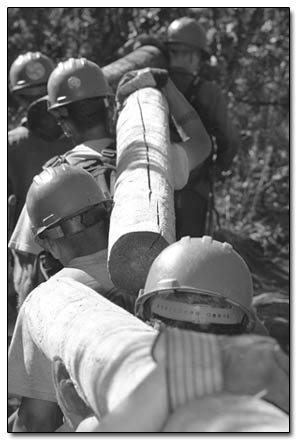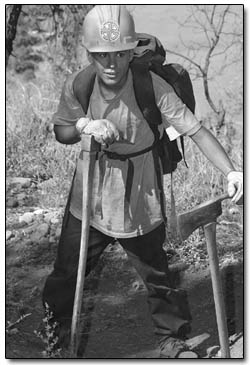|
Southwest Youth Corps crews hard
at work on public lands
written by Missy Votel
 |
| Members of a Southwest
Youth Corps crew lug 40-pound water bars up the Haflin
Creek Trail on Tuesday. The crew is one of several
that works each summer in the Four Corners area maintaining
trails, thinning trees and rehabilitating wildfire
areas./Photo by Todd Newcomer. |
It’s 10:30 in the morning a quarter
of the way up Haflin Creek Trail and 16-year-old John
Tolar’s mind has wandered to breakfast meats.
“I’m dreaming of bacon and sausage, sizzling,”
says the Bloomfield, N.M., teen as he makes his way up
the steep trail.
Tolar is among a group of 10 teens and young adults that
pounds the area’s trails by day and sleeps under
the stars by night. And while the description may sound
a little like summer camp, complete with yearnings for
a home-cooked meal, as Tolar and his peers can attest,
it’s anything but.
“We already went three miles this morning,”
says Tolar as he and two cohorts stop to take a breather
on one of the trail’s switchbacks. The group has
broken up into crews of three: two shouldering 40-pound
water bars while the third hauls tools – Pulaskis,
loppers, rakes and the like. For the last eight weeks,
the group, a work crew from the Southwest Youth Corps,
has been doing fire rehabilitation in the Missionary Ridge
burn area. Although it is only mid-morning, they have
been at work for hours, having first to retrieve their
tools from the previous days’ work site near Vallecito
after a last-minute change in work detail.
With only two days left in their project, the conversation
has turned to cold showers, clean clothes and –
of course – food.
 “There
are two vegans in the group, so we eat mostly beans and
rice, vegetables and tofu,” says Tolar, adding that
he doesn’t mind the group-imposed diet, but he does
partake in a private stash of meat occasionally. “I
packed my own potted meat, deviled ham and Beanie Weenies.” “There
are two vegans in the group, so we eat mostly beans and
rice, vegetables and tofu,” says Tolar, adding that
he doesn’t mind the group-imposed diet, but he does
partake in a private stash of meat occasionally. “I
packed my own potted meat, deviled ham and Beanie Weenies.”
Such adaptation is all part of the youth corps experience,
says the group’s executive director, Shannon Manfredi.
The crews work together anywhere from four weeks to five
months in a communal setting, which is vital to teaching
life skills. “They do everything as a group,”
she said. “They learn how to get along with other
people; they learn how to cook meals together; they learn
tolerance; and they learn appreciation.”
Modeled after the Civilian Conservation Corps of the
1930s, Manfredi said the Durango-based Southwest Youth
Corps is one of about 120 in the nation that provides
practical, on-the-job training for young adults. Projects,
which all take place in the Four Corners region, vary
from trail maintenance and fire rehab to park improvements
and civic beautification.
“They do work that probably wouldn’t get
done otherwise,” said Gary Mason, the Missionary
Ridge burn area rehabilitation supervisor with the San
Juan Public Lands office, who is guiding the Haflin crew
on its latest mission. And while the program is meant
to provide a community service, it also instills values
in the workers, he said. “The workers learn a strong
work ethic as well as stewardship for their public lands,”
he said.
Since it began in 1998 with 16 workers, the Southwest
Youth Corps has grown to employ more than 100 workers
each summer. The workers are split into crews of 10, which
include two supervisors, and are further divided according
to the work they do. There are roving day crews; frontcountry
crews, which work from base camps in a situation similar
to that of car camping; and backcountry crews, which operate
from remote locations at least three miles in. There also
is a fire fuels reduction crew as well as a leadership
program that grooms crew leaders, Manfredi said.
She said workers must possess two prerequisites: being
between the ages of 16 and 25 and having a willingness
to work. Other than that, they come from all over the
country and from various backgrounds, including college
graduates, high school drop outs and at-risk teens. However,
she said at least 75 percent of participants are from
the Four Corners area.
“We’re serving the local communities’
youth, so we try to reflect local communities’ demographics,”
she said, adding that for the most part, this includes
Anglos, Hispanics and American Indians.
 |
John Tolar, 16, of Bloomfield,
N.M., takes a
break from work on the Haflin Creek Trail in the
MIssionary Ridge burn area on Tuesday.
After his 8- week program wraps up work this week,
Tolar will begin another six-week program with the
corps./Photo by Todd Newcomer. |
She said the reasons people join are as varied as the
background from which they come.
“Some need money, some want to get away and see
other places, and some want job training,” she said.
Tolar falls into the latter group. He dropped out of
Bloomfield High School and joined the corps on June 1.
“I didn’t like going through metal detectors
at school and decided it wasn’t for me,” he
said.
With the money, experience and references from the youth
corps, he said he plans to earn his GED and take a course
in underwater welding. His plan is to eventually land
a job on a pipeline, the family trade.
“Everyone in my family worked on the Texas pipeline,”
he said. “I’m a pipeline baby.”
Jayson Bedker, 17, of Cortez, who is in his second summer
with the youth corps, said he plans to use the money he
saves to some day go into business with a friend. He also
has his eye set on an Americorps scholarship, which are
awarded to 17-year-olds in the program. According to Manfredi,
about 30 of the $1,000- to $2,400-scholarships are awarded
to participants each summer and can be applied to further
education.
“I’m hoping to use it for a mechanics degree,”
said Bedker.
Other program participants have a more direct link between
the work they are doing for the youth corps and their
future. Crystal Budd, 18, who is from Colorado Springs
and attends Brown University, said the corps is a good
way to gain experience for a future career in environmental
studies. Likewise, Shaun Elmore, 16, of Durango, said
he joined the corps because he loves the outdoors and
wants to pursue a career that involves wildlife and photography.
“I get to be outdoors, that’s the good thing
about it,” he said. “I love it.”
Allison Laramie, 23, a crew supervisor and recent college
graduate from Vermont, said she also enjoys the outdoor
aspect of the job, but that the diversity is perhaps an
even bigger asset.
“Growing up in Vermont, I was sheltered,”
she said. “But here I’m working with a diverse
group of teens. It’s fun working with this age group
and experiencing their growth with them.”
And as its members grow, Manfredi said she is hopeful
that the program will continue its growth as well –
benefiting not only local public lands but society as
a whole.
“We are dealing with youth and the environment,
the two most important things to our future.”
|

